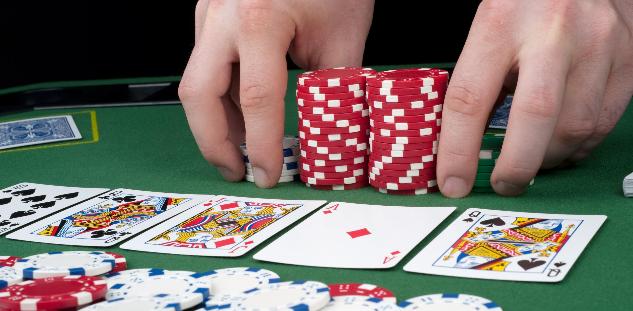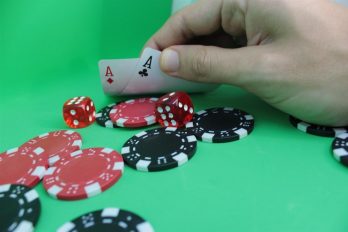10 Poker Tells You Can Use in the Casino
Nedplay 100% Welcome Bonus
Nedplay 100% Welcome Bonus

To win a game of live poker, you need to look out for your opponents tells. A tell is any mannerism that gives you a clue about your opponent’s hand. Additionally, a tell can show whether a player is bluffing. However, sometimes players use these mannerisms on purpose to trick other players into folding. For the best chance of success, it’s important to understand what each mannerism means. In this article, we explore 10 poker tells you can use in the casino.
Strong Exterior
If your opponent is acting like they have a strong hand, they probably don’t! When gambling, most play-ers put on a strong exterior to hide signs of weakness. This method isn’t just used in poker, either; in day-to-day life, many people make themselves appear confident to disguise feelings of weakness. To trick other plays into folding, gamblers often act like they have a strong hand. While this theory doesn’t work 100% of the time, it’s worth keeping in mind. So next time you’re playing, remember this tip.
Weak Exterior
Just as players put on a strong exterior to hide signs or weakness, they often put on a weak exterior to disguise signs of strength. If your opponent is acting like they’re unhappy or worried, they’re probably just acting! If they really had a weak hand, the last thing they would do is make it obvious. So generally, those that voice their dissatisfaction are trying to make you think their hand is weak when it’s actually strong!
Shaking Hands
Another thing to watch out for is shaking hands. During poker, many people associate shaking hands with bad cards. As hand-shaking is a sign of nerves, it’s not unusual to assume that your opponent is nervous because his cards aren’t good. However, it’s often the opposite. Shaking hands usually indicate a strong hand. Hand-shaking is a release of nervous energy. But instead of being nervous about losing, the hand shaker is nervous about the excitement of winning.
Speed of Breathing
Paying attention to your opponent’s breathing can also be helpful. When we become stressed, our breathing naturally gets faster. However, many players are aware of this. To hide their stress, they con-sciously slow their breathing or stop breathing entirely. Unfortunately, this can give the game away to those in the know. If a player is breathing too fast or too slow, they are probably stressed about their cards.
Staring into Space
If your opponent is staring into space, they probably have a strong hand. As we mentioned earlier, play-ers often disguise a strong hand by appearing weak. Players assume that staring into space will make them appear uninterested in the game, and therefore mean that they have bad cards. However, if their cards were so bad that they stopped caring about the game, they probably would have already folded. So if your opponent is looking around the room instead of at their cards, they’re probably trying to hide a strong hand!
Head-Nodding
Head-nodding is another sign of a weak hand. As mentioned previously, a strong exterior can be a sign of weakness. During poker, those with bad cards often voice their confidence to trick other players. Re-search has shown that head-nodders are usually bluffing, while those that remain still have a strong hand.
Sentence Fillers
To determine whether a player is bluffing, watch out for sentence fillers. Using words like ‘erm’ and ‘er’ can be a sign of lying. When telling a story that is untrue, the liar makes up the content as they go along. Sentence fillers can indicate gaps in the thinking process where the liar is making up the next part of the story. If you want to catch a bluffer, try asking them directly if they are bluffing. If they answer ‘er, no’, they probably are!
Hand Gestures
According to research, 40% of liars use excessive hand movement while only 20% of truth-tellers use hand gestures. If your opponent is talking, take a look at their hands. Are they moving more than usual? If you’re playing against a friend, excessive hand movement can be easy to spot. However, if you’re playing against a stranger it can be a little harder. If you can, take a note of their use of hand gestures early on so you can determine whether it increases during the game.
Direct Eye-Contact
Many people believe that liars avoid direct eye-contact. However, research has proved this to be untrue. To convince others they are telling the truth, liars often use direct eye-contact. However, truth-tellers also use direct eye-contact, so spotting a bluffer can be tricky. On average, liars use direct eye-contact 10% more than those telling the truth. So if your opponents eye-contact seems excessive, they may be bluffing!
Looking at Chips
If your opponent is looking at your chips, they probably have a strong hand. Typically, players that are looking at your chip pile are trying to work out how much to bet and trying to figure out how much they can win from you.
In Summary
Whether you’re an avid gambler or a complete novice, use these tells to spot a poker bluff. If your oppo-nent is using excessive hand gestures, direct eye-contact, or appearing over-confident – they’re probably bluffing! As always, it’s important to consider your financial situation before using a casino. The occasional bad day is unavoidable, and it’s easy to keep playing in an attempt to win your money back. However, this almost always ends badly. If you’re on a losing streak, the best thing to do is head home and return an-other day. Chances are, you’ll eventually win your money back.



